ESCAPE
A shipwreck road trip – in search of swimming pigs and rusty memories
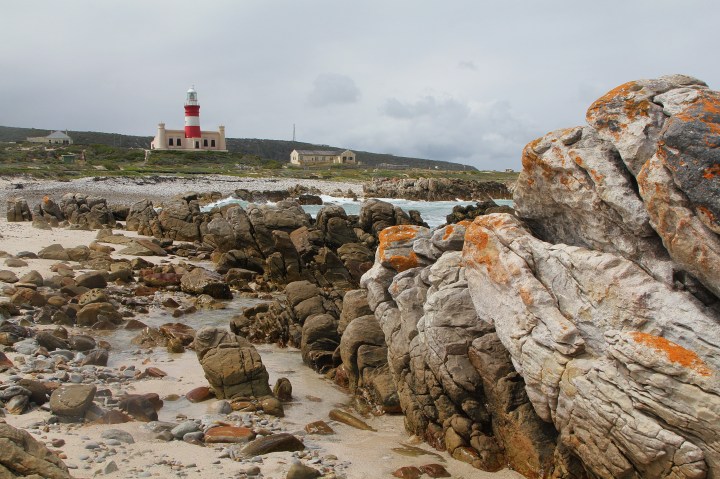
We found ourselves wandering about the Bredasdorp Shipwreck Museum, completely engrossed in the stories of storm-tossed vessels, human folly and all the stuff that washed up on the shores of the southern Cape coast. It might surprise you to discover that, at a rough estimate, for every one of South Africa’s 3,000-odd kilometres of coastline, there is at least one shipwreck site.
We’re stoep-sitting somewhere in dusty old Nieu-Bethesda the other day, minding everybody’s business but our own, when this clutch of nervy, black-spotted Kolbroek pigs comes trotting by. I’d like to know where the rather snappy name of Kolbroek comes from. A fellow stoep-sitter shares this theory:
“They say the first spotted pigs in South Africa swam ashore from the wreck of the Colebrooke somewhere on the Cape coast back in the late 1700s.”
The modern-day Kolbroek porker can claim his genetics from sub-breeds such as Windsnyer, Sandveld Red, Great White and Tamworth – with a bit of African bush pig thrown in for hardiness.
The subject of swimming pigs and broken boats is so dramatic and delicious that my wife and I decide to take a road trip down to the heart of shipwreck country: the Agulhas Plain.
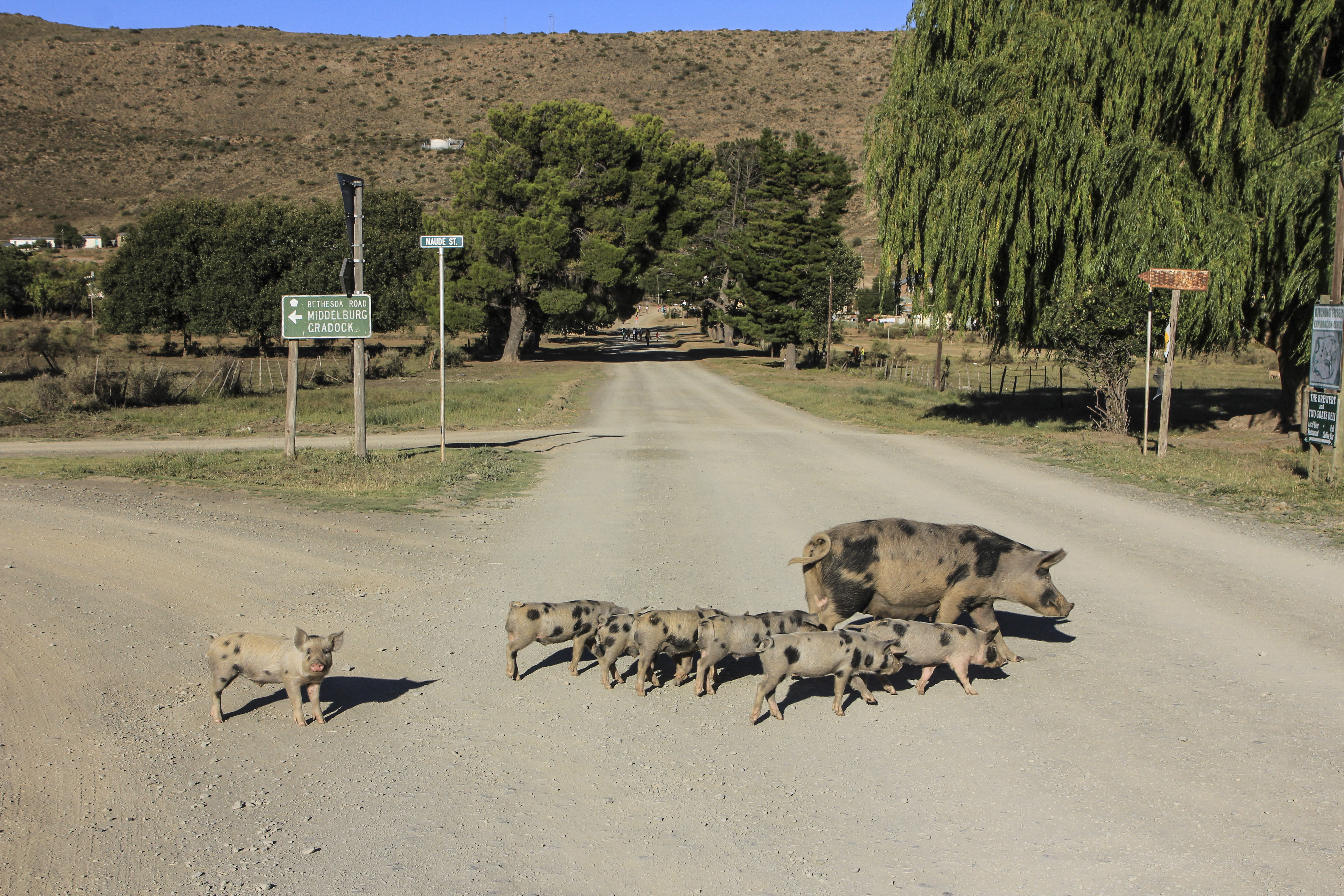
Kolbroek might refer to the pigs’ spotted hams – or is there another reason? Photographer: Chris Marais
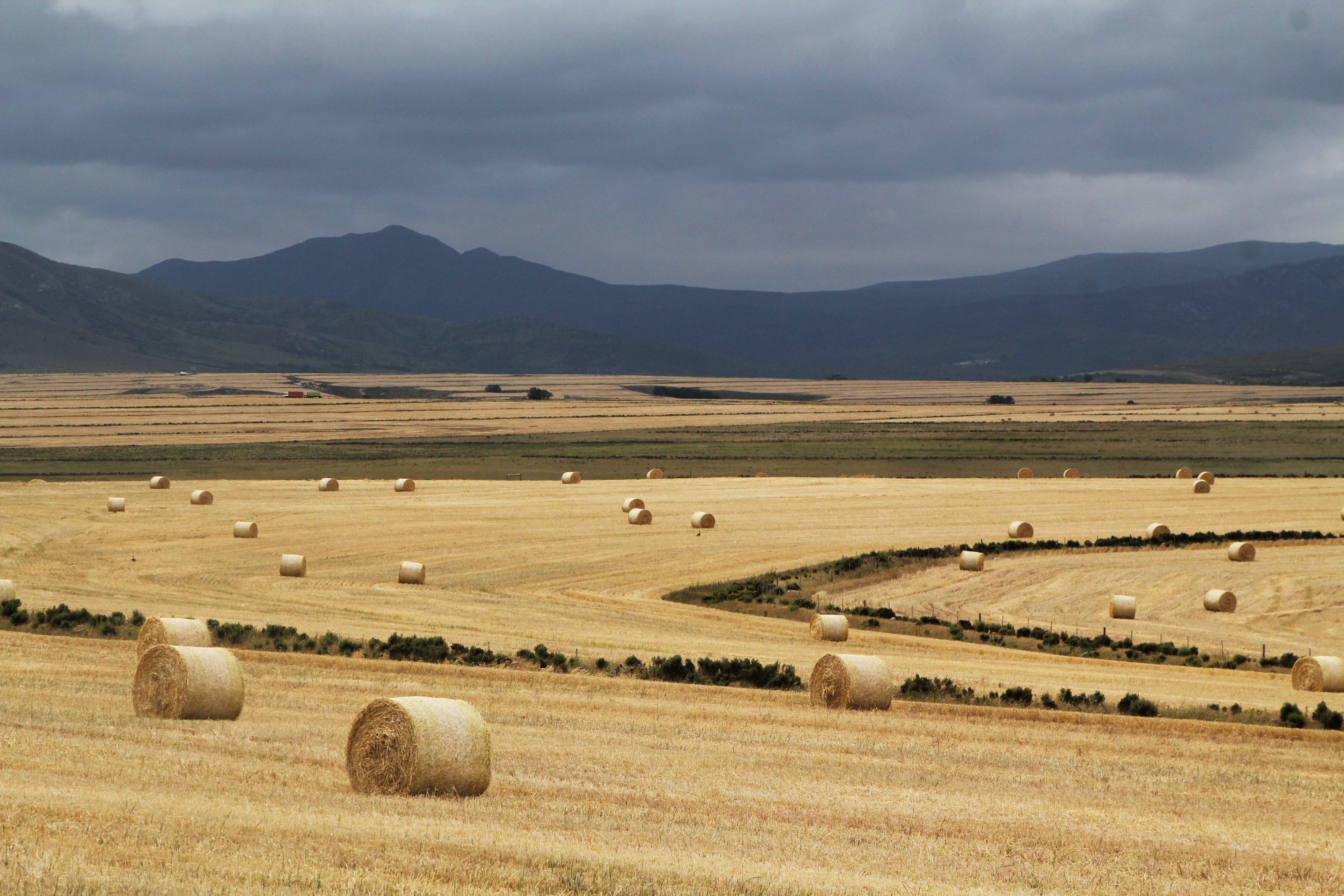
Inland Overberg is all about wheatfields, brooding mountains and canola. Photographer: Chris Marais
Treasures in the Shipwreck Museum
And so, months later, we find ourselves wandering about the Bredasdorp Shipwreck Museum completely engrossed in the stories of storm-tossed vessels, human folly and all the stuff that washed up on the shores of the southern Cape coast. We also hope to nail down the legend of the handsome Kolbroek pig.
It might surprise you to discover that, at a rough estimate, for every one of South Africa’s 3,000-odd kilometres of coastline, there is at least one shipwreck site. Some, admittedly, have disintegrated into nothing more than a half-remembered story while others are still around, their rusty hulks hosting all manner of sea life.
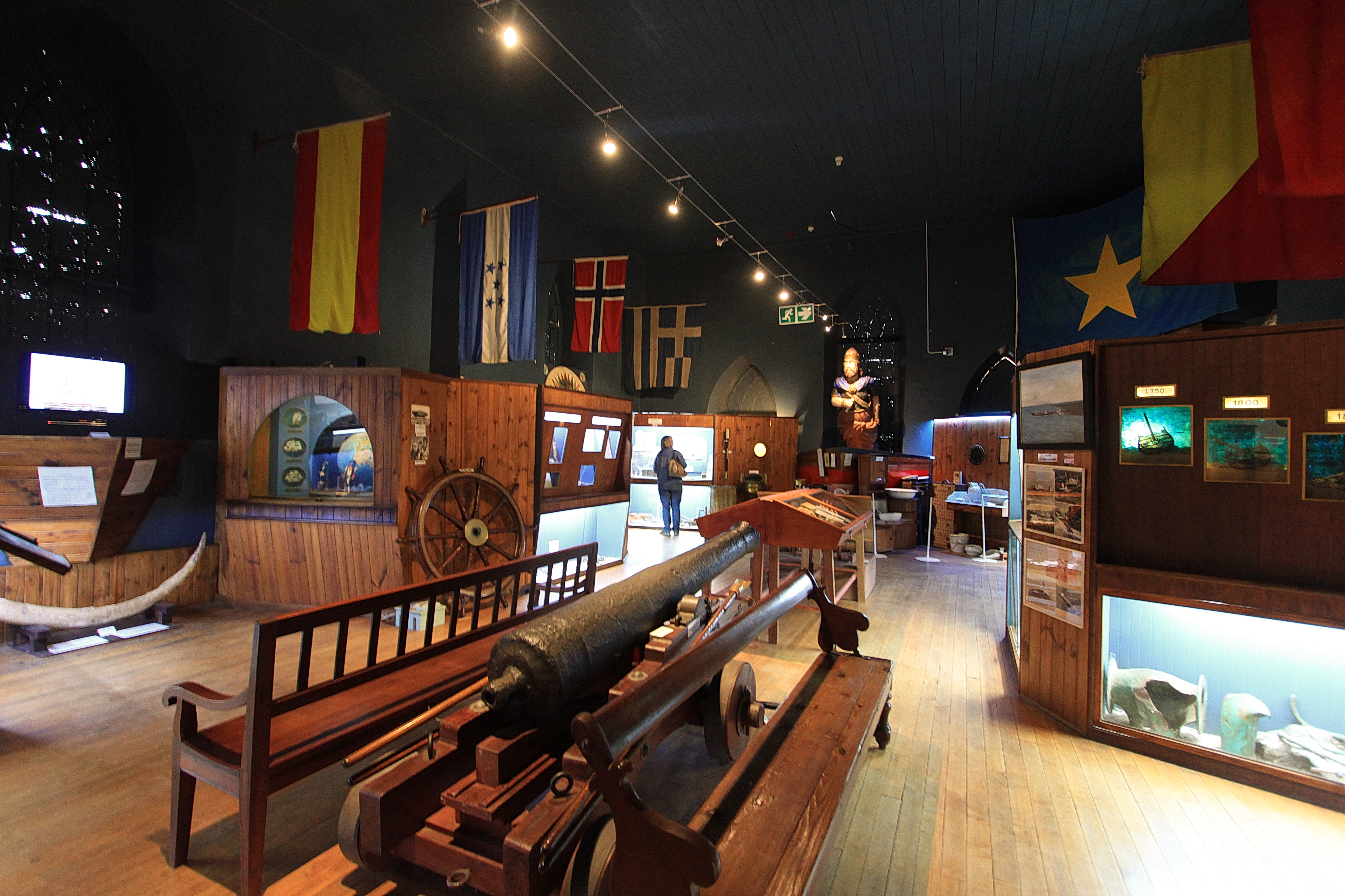
Cannons, portholes, clay pipes, ballast bricks, basins, dinner sets, coins, figureheads – all retrieved from South Africa’s shipwreck-rich coastline. Photographer: Chris Marais
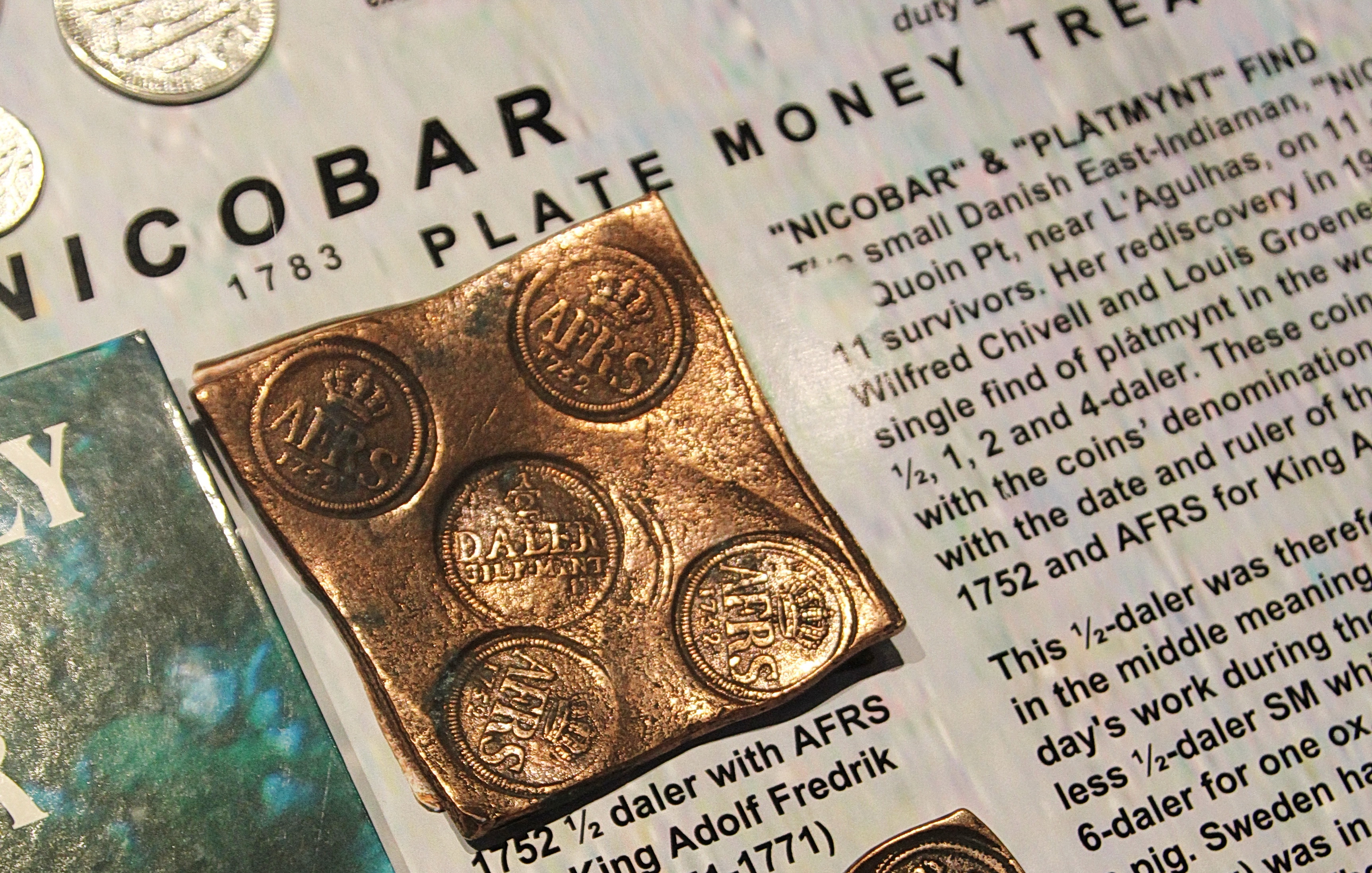
Plate money from the Nicobar, retrieved by Gansbaai conservationist Wilfred Chivell and a diving friend, Louis Groenewald. Photographer: Chris Marais
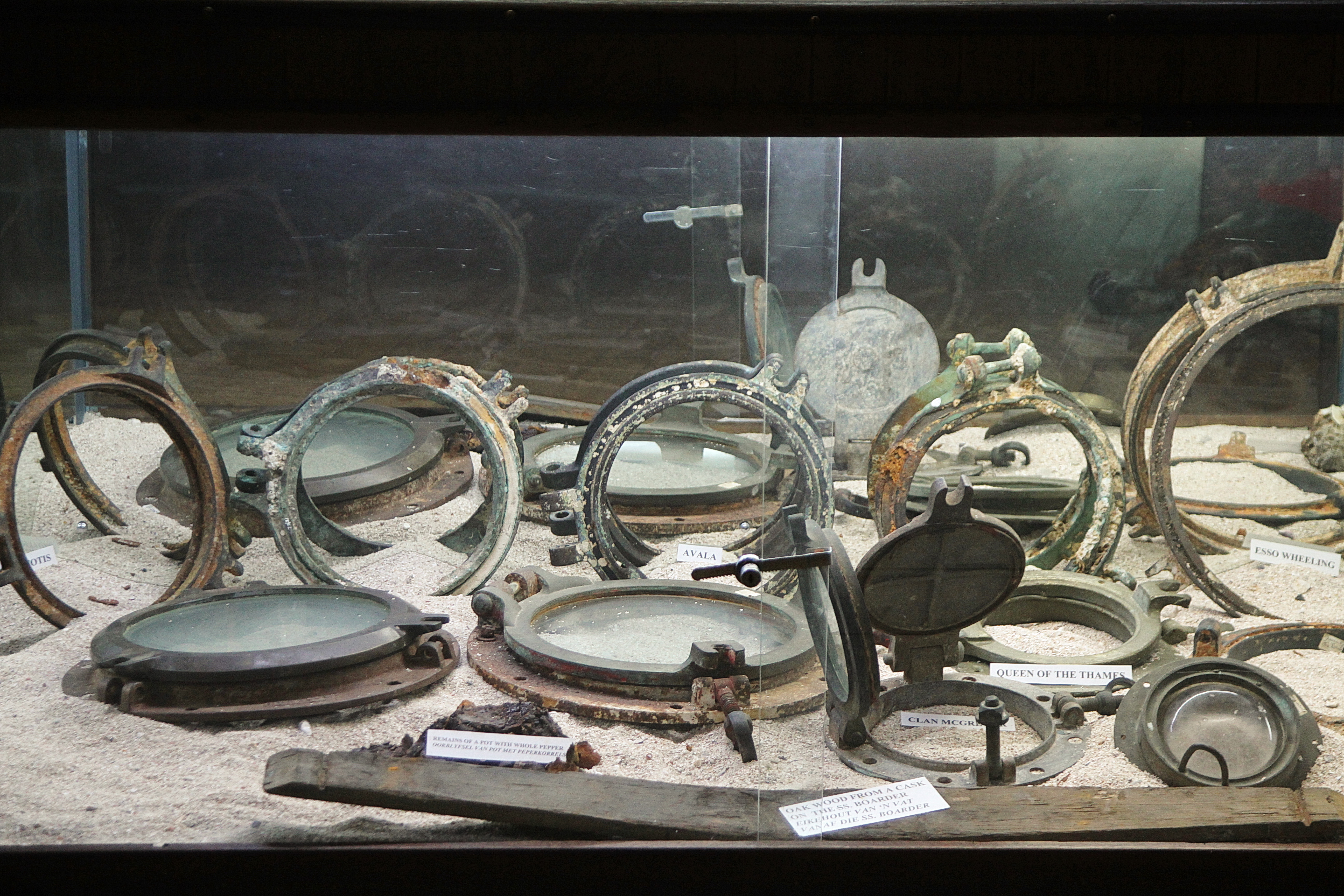
Portholes seem to be made of very durable metal. Photographer: Chris Marais
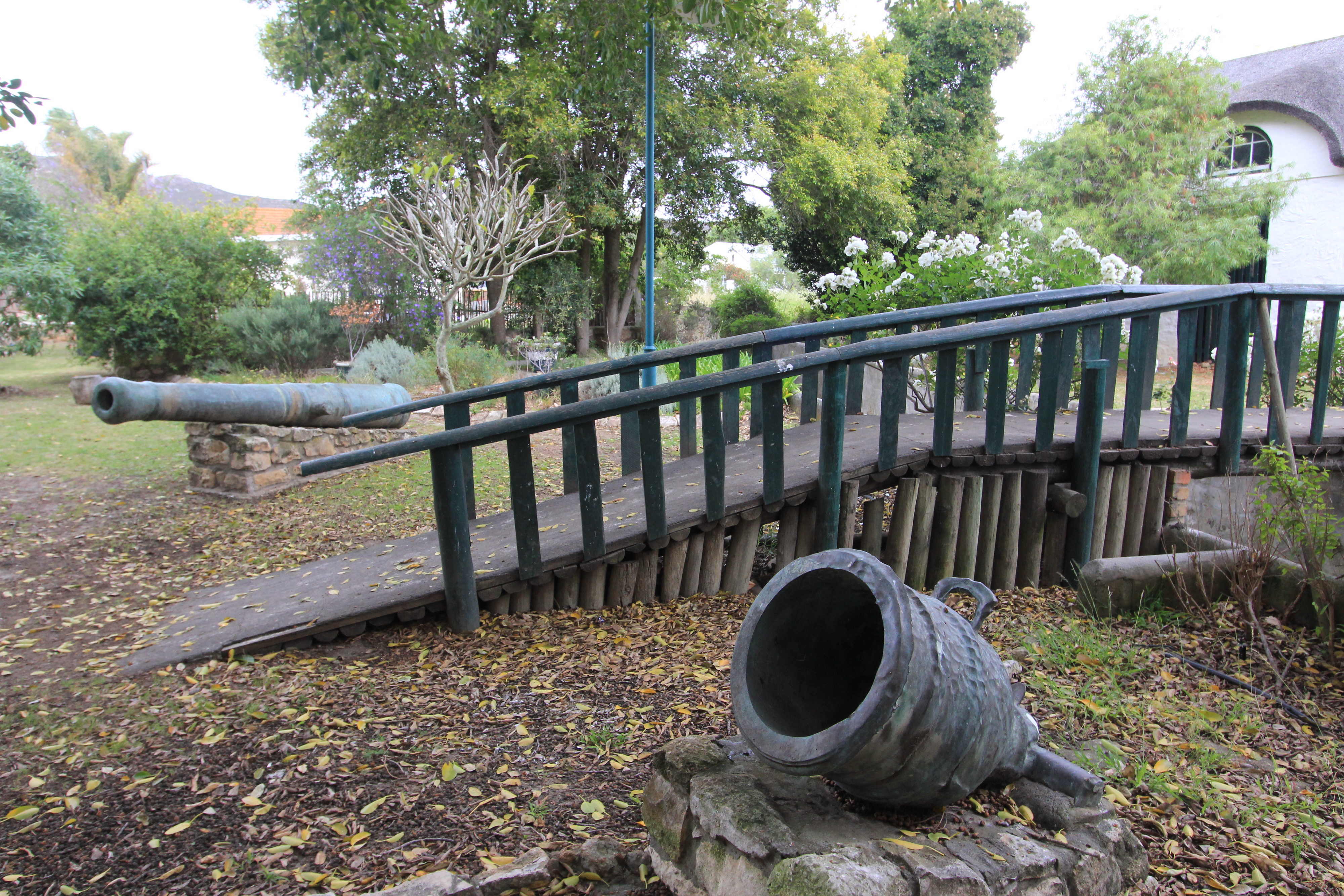
In the gardens of the Shipwreck Museum, you’ll find old cannons and massive anchors. Photographer: Chris Marais
The Shipwreck Museum displays the remains of many vessels, both famous and forgettable, in the form of cannons, brass porthole frames, ballast bricks, crockery, compasses, clay pipes, copper nails and coins.
The copper-plate coin collection, in particular, grabs our attention. That’s mainly because we’re friends with one of the divers who salvaged a treasure box of these coins from the wreck of a Danish ship called the Nicobar, back in 1987. The Nicobar was wrecked near Quoin Point in 1783, and more than two centuries later Wilfred Chivell and Louis Groenewald were diving in the area when they spotted a ship’s cannon and a large box, later found to contain the biggest cache of copper-plate money ever recovered from the oceans. Now we can truly tell people we know someone who has actually found a hidden treasure in the sea: Wilfred Chivell, who owns and runs the diverse Marine Dynamics company out of Gansbaai.
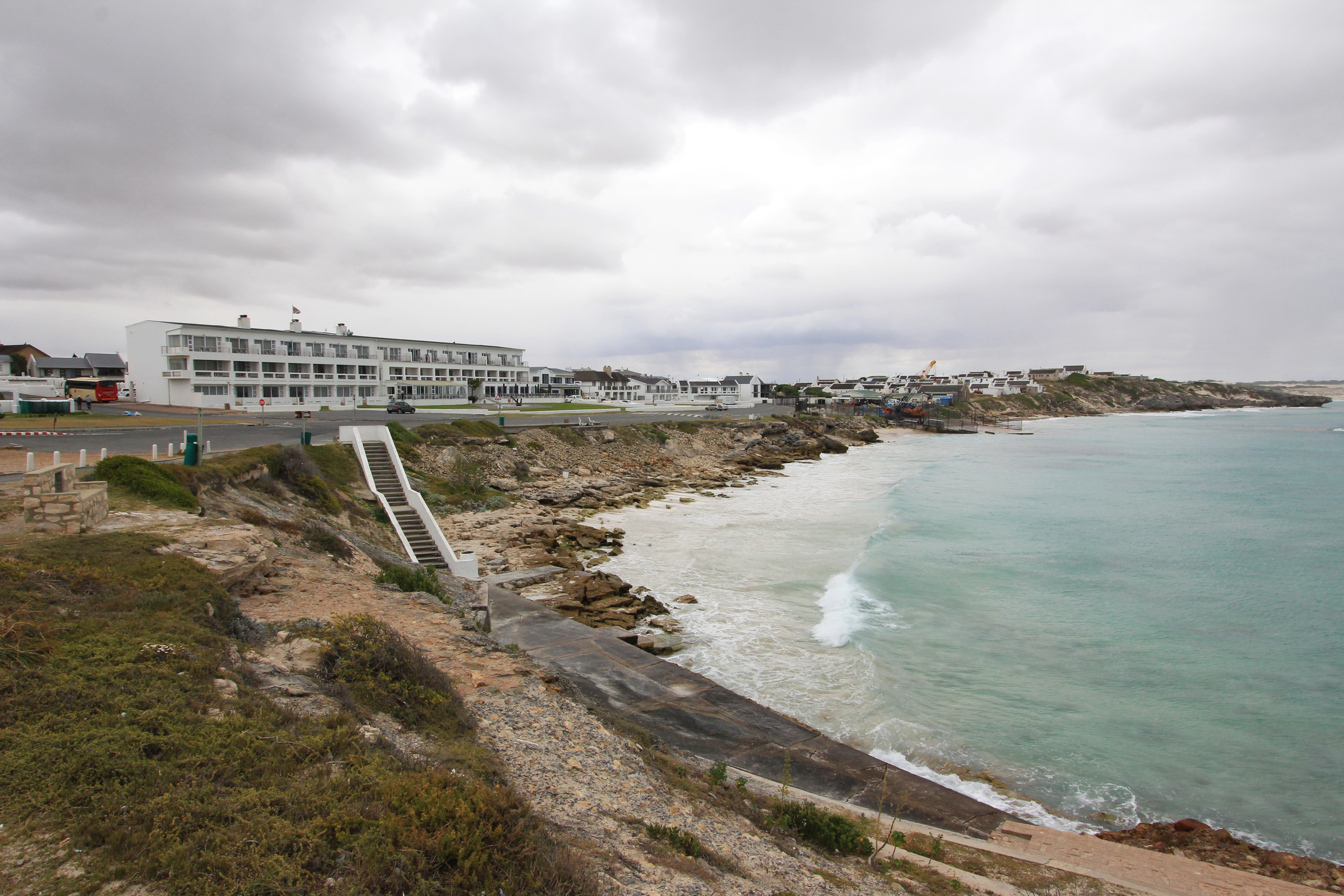
The shorefront of Arniston from the shipwreck memorial, over the hotel, towards the fishing village of Kassiesbaai. Photographer: Chris Marais

A currently more grizzled Chris Marais at a freshly-painted Southernmost Café in Africa. Photographer: Chris Marais
Female figureheads
There was a time when topless female figureheads were all the rage in the maritime world, fitted to the ship’s bow as some kind of sacrifice to the spirits that dwell in the sea. The figureheads in the museum are of sword-drawing knights, eminent burghers and one particular lady who appears to be in perpetual discomfort. There was also a time when, in parts of Europe, figureheads came with kaboutermannekes, small gnomish men of magic who guarded the vessel against sickness and storms.
If, by some mischance, the ship sank, the kaboutermanneke would escort the drowned sailors’ souls off to the Land of the Dead.
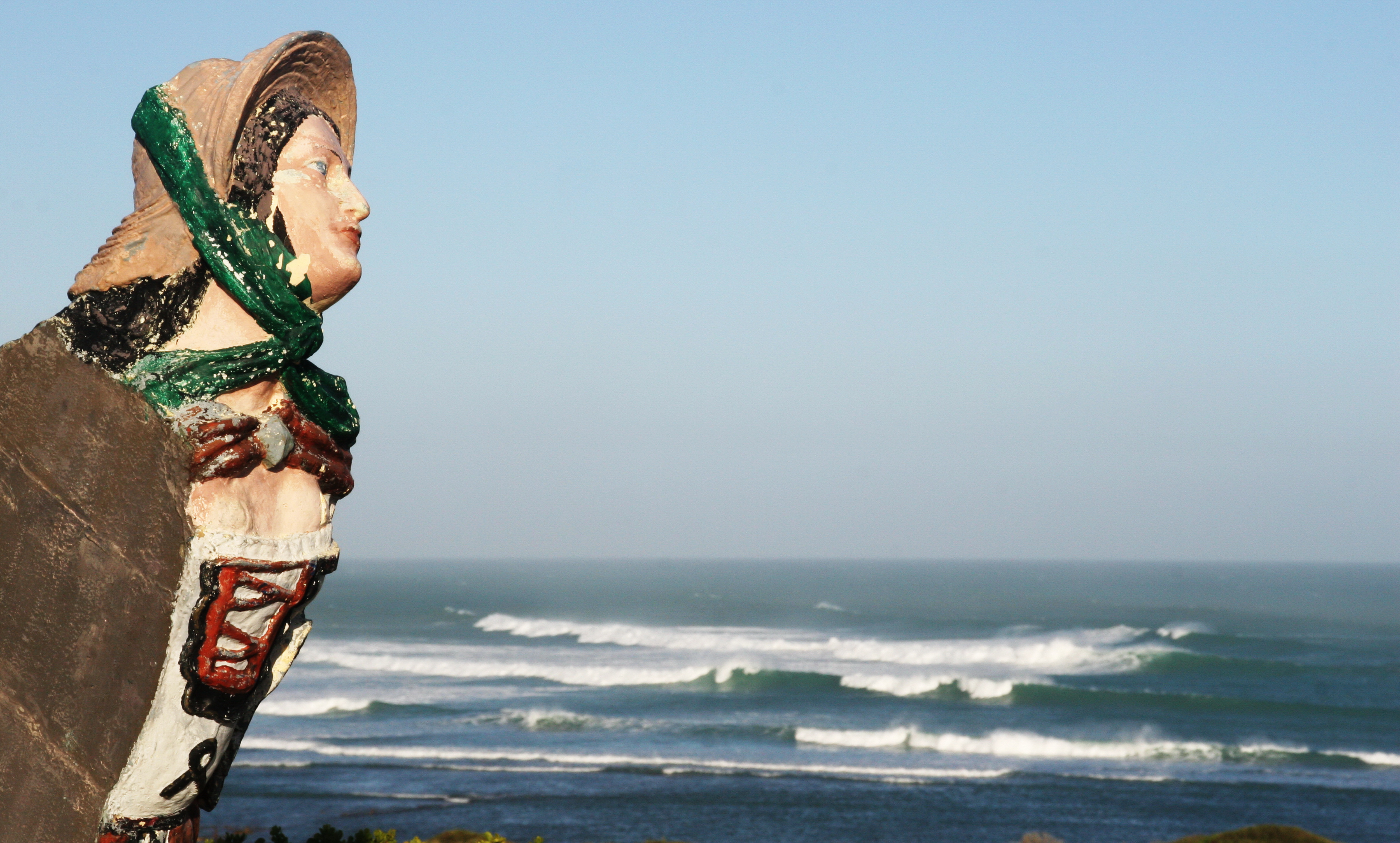
The so-called Wooden Lady of Agulhas is a figurehead from the Marie Elise, wrecked at Agulhas in 1877 and washed ashore close to the present-day lighthouse. Photographer: Chris Marais
These fairy gnomes would have been particularly busy in the waters off the Agulhas coastline, a fact which deeply troubled one Michiel van Breda, owner of the farm Zoetendal’s Vlei. He begged the local authorities thus:
“I have been painfully called on to witness ship after ship cast away, valuable cargoes strewn along the beach and hundreds of human beings at a time washed up dead upon the shore.”
As a result of his pleas, the Cape Agulhas lighthouse was built.
Stepping further into this fascinating den of maritime history, we enter one part of the old converted house packed with furniture recovered from local wrecks. Here is shiny silverware from the Lisboa (1910), a bar counter from the Clan McGregor (1902), a cabinet from the Arniston (1815), and a marble-top counter from the Queen of the Thames (1871), which once did good service in a Bredasdorp doctor’s rooms.
“This must be the proverbial tip of the iceberg,” my wife whispers. “Can you imagine what’s out there in the homes and farmsteads of the whole district?”
“No,” I reply. “But just come and look at the sky – it’s getting darker and darker. Shipwreck weather. Shall we go for a drive?”
Shipwreck weather drive
We head off into the gunmetal gloom of mid-morning, with winds rising and more storm clouds gathering to the south. Apart from a site visit to various wreck locations, this is also going to be a little trip into our personal past. Just more than 18 years ago, we came this way as part of a gruelling three-month, two-book journey (Shorelines, Coast to Coast) along the whole South African coast, from Alexander Bay to Kosi Bay.
Our first stop today is the village of Arniston, where we sit in the parking lot in our bakkie, watch the waves and recall a night of binge-TV in the Arniston Hotel, and a church service in the neighbouring Kassiesbaai fishing village.
I remember, in particular, a very strange fish trophy mounted on one of the lounge walls in the hotel. They called it Die Bokvis, on account of its two red horns. Disclaimer: Superglue was probably involved in the making of Die Bokvis.
On the night of 30 May 1815, that part of the southern Cape coast was the scene of a vicious squall that brewed off the Agulhas Bank and enveloped a British transport ship called the Arniston. The vessel was bound for England from Ceylon, and she carried 378 passengers and crew. Some say that Captain George Simpson headed the vessel for land, thinking he was actually just off Table Bay. According to reports, the Arniston hit a reef just more than a kilometre out to sea and began to break up.
Only six men, clinging onto flotsam, reached the shore alive. The hull of the ship eventually grounded itself on the beach, surrounded by hundreds of washed-up bodies. The survivors took refuge in a nearby cave and lived off a bag of oatmeal they had found in the wreckage. They were discovered two weeks later by a farmer’s son and a shepherd and eventually made their way to Cape Town.
Nearly two months later, an auction was held on the beach near the crash site where the surviving contents of the Arniston were dispersed. Some of the goods for sale included 122 casks of wine and arrack.
I’m particularly keen to move on from the Arniston Parking Lot of Crazy Memories to Cape Agulhas, because they have a peachy lighthouse over there. The one that Michiel van Breda (who later became Cape Town’s first mayor) agitated for, all those decades ago.
Southernmost tip of Africa
In the thin drizzle and gloomy light (which we call “great weather” in the Karoo), the pewter-toned seas around Agulhas look like they might soon become restless. Right now, however, the waves aren’t even large enough to tip over a toddler’s lilo.
As we chug slowly through the holiday villages of Struisbaai and L’Agulhas, we marvel at the names of the beach homes:
Nooit te Vol, La Petite, Tides Joy, Eersterat, Pint inni Wind, Sommerso, Pondjie Botter, and our personal favourite, Swem Jannie.
At the Southernmost Café in Africa, we stop for a photo exactly as we did on the Shorelines trip of 2005, and buy a bag of nuts. The lighthouse art on the side of the café has been repainted, the nuts cost a bit more than they used to and my hair has turned grey.
The actual Agulhas lighthouse, with its classic proportions and pleasing lines, stands proud on a rise at the end of a long parade of jagged rocks.
With Gansbaai and Franskraal on our road trip radar, we pass through the Moravian village of Elim. This incredible thatched settlement has been helping shipwreck survivors since way back in 1838, when they gave food and shelter to those washed ashore from the stricken Duke of Northumberland, a troop ship that broke up near Cape Agulhas.
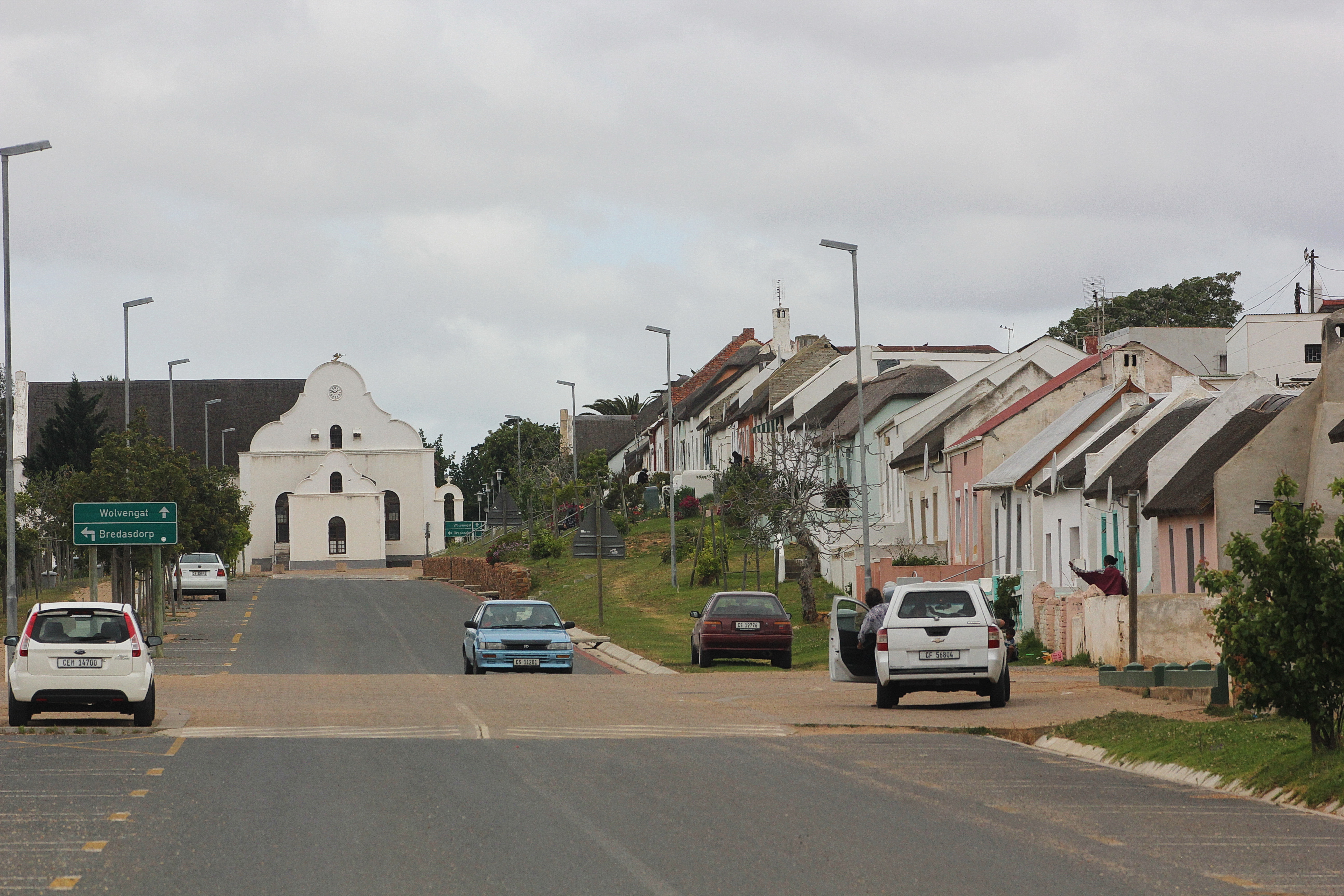
The Moravian mission town of Elim, whose residents gave succour to shipwreck survivors 170 years ago. Photographer: Chris Marais
A year later they fed the survivors from the Jessie, wrecked nearby at Quoin Point.
On the way into Gansbaai, we pass the turn-off to Franskraal, where Jan “Pyp” Fourie and his wife SD had the Strandveld Museum when we met them back in 2005.
The last time we were here, they took us through this extraordinary museum and its displays: a pictorial history of the first industries of guano and seal clubbing; a mattress filled with penguin down (the slightest touch made a dent in it); old baby clothes; a carved wooden doll for a lighthouse keeper’s daughter; and remnants from the wreck of the Bulwark in 1963. Part of the cargo consisted of barrel upon barrel of top-quality sweet wine.
The men who first found the barrels got rip-roaring drunk. Then their wives who came to castigate them joined in and fell over as well. In fact, the whole of Gansbaai was drunk for a week. The only sober person was the dominie, they say.
Back then I bought one of Jan’s books, Dawn at Dyer, in which he offers a lively description of a modern-day wreck diver:
“His vehicle looks somewhat dilapidated, but his boat and diving equipment are treasured … His needs are limited. A few litres of fuel take him to his diving spot. A can of beer and a bar of chocolate supply the necessary stamina.”
HMS Birkenhead
After a brief stop at Kleinbaai and a stroll around the shark-spotting boats, we drive on through to the Danger Point lighthouse, currently shrouded in storm light. The ocean is beginning to boom and thud on the rocks below.
If you stand at the marker just below the lighthouse and follow its directions out to sea, you’ll find yourself staring at the exact spot where the troopship HMS Birkenhead went down on 26 February 1852. She was carrying British soldiers, reinforcements for the border wars with the Xhosa. The Birkenhead was doing about eight knots when she hit a rock just more than two kilometres south-west of Danger Point.

The words “Women and children first,” was first uttered as those aboard the Birkenhead ran to the lifeboats after the ship foundered at Danger Point near Gansbaai. Only 193 out of 634 people survived. Photographer: Chris Marais

Kleinbaai, part of the greater Gansbaai, is where most whale and shark-viewing vessels depart from. Photographer: Chris Marais

Preparing for the day’s marine spotting adventures. Photographer: Chris Marais

Neptune and his Kings of the Sea (sharks) immortalised at Kleinbaai close to Gansbaai. Photographer: Chris Marais

Dickie Chivell and his father Wilfred, who run Marine Dynamics and Dyer Island Conservation Trust at Kleinbaai. Photographer: Chris Marais

Gansbaai may be a marine ecotourism destination, but is also a major fisheries port. Photographer: Chris Marais

The late and legendary Jan Fourie of Franskraal’s Strandveld Museum as we found him 15 years ago. Photographer: Chris Marais

Common terns near Danger Point, their orange bills indicating they are looking for mates. Photographer: Chris Marais

Danger Point lighthouse was finished in 1895, more than forty years after the Birkenhead sank nearby. Photographer: Chris Marais

There are treacherous rocks above and below the water near present-day Gansbaai, which is why Portuguese mariners, starting with Bartholomeu Dias, named this area Danger Point. Photographer: Chris Marais
The bottom of the ship was torn out. Only three of the eight lifeboats could be released into the sea. All the women and children were ordered into the boats and the men were told to hold back. As the Birkenhead sank, the soldiers and sailors on board tried to swim to shore, and the cruising sharks in the area feasted. While historical accounts vary as to the exact number of people onboard, at least 440 people died and only 193 survived.
Most travellers know the well-branded Birkenhead legends (and enjoy a local ale of the same name), but few recall the more recent wrecks of World War 2, when German U-boats patrolled these waters like the sharks that slide around Gansbaai these days.
Just refer to your copy of Dawn at Dyer (if you’re lucky enough to possess one, because they’re rarer than megalodon teeth) where Jan Fourie (who passed away a couple of years ago) writes:
“Of the approximate 200 ships sunk in WWII along the South African coast, 80 lie on the seabed between Cape Town and L’Agulhas. Wreckage and cargo from torpedoed ships frequently washed up on the beaches of the Overberg. Customs officers kept a watchful eye, but now and then somebody managed to get away with loot.”
And through the midst of all this debris, treasure and gasping survivors came a couple of Kolbroek pigs, whose descendants trotted right into the heart of the Karoo and never left.
And I’d love to sign this story off on that note, but unfortunately, I have since discovered that the Colebrooke had no pigs on board when it went aground.
Sometimes a kol is simply the Afrikaans word for a spot… DM
Chris Marais and Julienne du Toit are the authors of Shorelines: A Journey Along the South African Coast (armchair travel) and Coast to Coast: Life along South Africa’s Shores (coffee table pictorial). A limited two-book-special first edition autographed copy of Shorelines and Coast to Coast costs R600 (including courier service in South Africa). Enquiries: julie@karoospace.co.za
The Strandveld Museum at Franskraal is usually open on weekdays from 9am to 3.30pm. It’s advisable to contact SD Fourie on 082 255 8509 before your visit.

















Love reading your stories Chris, and experiencing the hidden gems of our beautiful country through your accounts and photographs.
What a lovely article.
I have always been fascinated with the shipwrecks off the South African coastline. I managed to find a second hand copy of Shipwrecks and Salvage in South Africa by Malcolm Turner. Published 1988. It’s sad to think how many ships were lost tragically. Whilst on holiday on Ibo Island in Mocambique in 2015, I managed to smuggle my metal detecor in with me. While searching by the sea wall, I found a small swivel cannon. I dug it out with my hands !! (forgot to pack a spade) Painfull. I had to leave the cannon in Mocambique but I’ve always wondered what ship It came from. There were no markings. The sand by the jetty at Ibo was covered by bits of blue and white porcelain.
The seacoast around africa is littered with debris from lost ships..
Thank you